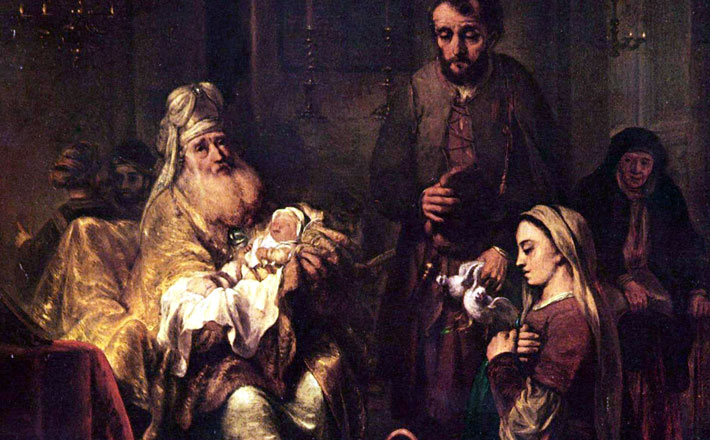Commentary on Luke 2:21-38
This pericope serves as the closing of the infancy narrative, and it contains four clearly marked scenes, new characters, and another song.
The preacher may want to focus on one or two scenes, as attempting to address all the scenes has the potential to confuse the hearer of the sermon.
Luke again shows a desire to record an accurate history of the events by providing specific details about time and location. Likewise, Luke is placing these events within the history of salvation as revealed throughout Scripture by having the Holy Family do what was customary in the Law.
First scene: Naming and circumcision (21)
What may seem like an incidental mention in one verse does have importance for the conclusion of the infancy narrative. In the previous chapter, Luke notes that Zechariah and Elizabeth had John circumcised; here, Mary and Joseph have Jesus circumcised. Both families are following an important Jewish ritual, one that marks Jewish males as part of the covenantal community. At the same time, over a century before these events took place, circumcision had been banned by a king who wanted to instill Greek culture in the land; thus, circumcision was also a ritual of resistance, one that resonates with Mary’s Magnificat in Luke 1.
The act of naming may be even more important in this one-verse scene. Concern about Jesus’ name started back at the beginning of the infancy narrative, with Gabriel instructing Mary to name the child-to-be “Jesus,” meaning “the Lord saves” in Hebrew. The giving of Jesus’ name on the eighth day fulfills what had been said at the Annunciation. From Paul’s letter to the Philippians (2:6-11), we know that the name of Jesus has its own power, such that it brings all of creation into worship.
Names are important for establishing and maintaining identity, and the preacher may want to reflect on the multiple identities each person has besides just a name.
Second scene: Presentation and purification (22-27)
Although the first three verses of this scene are dedicated to the legal requirements, the preacher should not become overwhelmed by them. Two rituals are occurring: Jesus’ dedication and Mary’s purification. Both rituals connect back to Hannah and Samuel in the Hebrew Bible (1 Samuel 1:24-28; 2:20-22). Just as Samuel “grew up in the presence of the Lord,” so too does Jesus—but even more so!
This parallelism may explain why Jesus’ dedication was happening in the Temple, which was not a legal requirement. The Temple, which also appears in the next pericope and near the end of Jesus’ ministry, connects to divinity and God’s presence. Such presence—the Holy Spirit—is what guides Simeon to the Holy Family. Simeon was a man looking for the “consolation of Israel” that would be brought about by the Messiah. This phrase is not just about fulfillment but also restoration, again pointing back to what Mary proclaimed in her song.
The Holy Spirit also ties this part of the infancy narrative to the others, as she comes upon John, Mary, Elizabeth, and Zechariah.
Simeon’s song: Nunc dimittis (28-32)
This canticle has been associated with Evening Prayer in the East and Night Prayer in the West since the fourth century. The language of dismissal makes it ideal for singing before falling asleep. It has also been associated with funerals because of its fulfillment language.
The images of the song parallel the writings of the prophet Isaiah (40:1-2; 51:3; 52:9), and this is not the last time Isaiah appears in Luke’s gospel (see Isaiah 61:1-11). The song is tangentially related to Jesus’ birth but is primarily a revelation about who Jesus is, which is why Simeon can be at peace.
Simeon notes that the salvation he sees coming in Jesus is not restricted to one group or another, but it is placed “in the presence of all people.” Thus, God’s presence is not restricted to the Temple but flows outward to all creation.
Third scene: Simeon’s blessing (33-35)
Simeon’s song does not conclude his time with the Holy Family, for after giving thanks to God he proclaims a blessing to them. It is somewhat puzzling as to why Mary and Joseph were amazed at what Simeon had just said, as they had been party to such revelations from Gabriel and the shepherds in previous parts of the infancy narrative.
After blessing the family, Simeon speaks directly to Mary of Jesus’ power, echoing language that Mary herself used in the Magnificat. The language of “falling and rising” is not to be understood as sequential but as different groups in society. It is also speaking of opposing tensions, as Jesus will later speak of being both the “stumbling block and cornerstone” later in Luke (20:17; quoting Psalm 118:22).
Such tension is also present in Simeon’s warning about how Mary will experience these things. Luke does not record Mary being at the crucifixion, so it may not be foreshadowing, but certainly the events of Jesus’ life and his politically staged death will adversely affect Mary. The joy of the Christmas season is already pierced by impending sorrow, as described in the second stanzas of the hymn “What Child Is This”: “Nails, spear shall pierce him through, the cross be borne for me, for you; hail, hail the Word made flesh, the babe, the son of Mary.”
Fourth scene: Anna’s blessing (36-38)
Simeon is not the only pious individual to encounter the Holy Family at the Temple. Anna, whose lineage Luke describes, continues the tradition of Hebrew female prophets, revealing God’s message like others in the infancy narrative. Luke does not record her exact words, but in noting that she “praised God” may indicate that her words were like that of Simeon’s. She speaks about redemption, which parallels Simeon’s concern about restoration. Again, these revealed actions of Jesus point back to Mary’s song of praise and also point forward to Jesus’ ministry, cross, and resurrection.
PRAYER OF THE DAY
Glory of Israel,
The coming of your son, Jesus, broke open the heavens and prepared a way for all of your children to come home to you. Give us eyes to see your miraculous spirit moving in this church and in this world. Teach us to be proclaimers of your love to the nations, for the sake of the one whose name is redemption for the peoples,
Jesus Christ our salvation. Amen.
HYMNS
The bells of Christmas ELW 298
Lord, dismiss us with your blessing ELW 545, H82 344, UMH 671, NCH 77
At the name of Jesus ELW 416, H82 435, UMH 168
CHORAL
Nunc dimittis, Robert Scholz


December 27, 2020